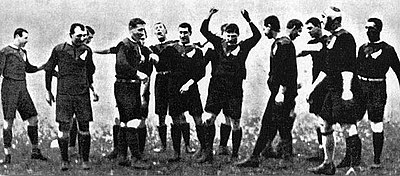Portal:New Zealand/Selected article/2007
See Previous articles for earlier Selected articles. For 2006 Selected articles see Portal:New Zealand/Selected article/2006
Weeks in 2007
[edit]- Week 1
The Christian Heritage Party of New Zealand (CHP, known for a time simply as Christian Heritage New Zealand) functioned in the New Zealand political landscape as a party promoting evangelical Christian-based social conservatism. Although it had a representative in the Parliament for a brief period, it never won any seats in an election, its sole Parliamentary representation stemming from the defection of the Alliance MP Frank Grover in June 1999. The Party did however come close to winning representation in the 1996 election as part of the Christian Coalition.
- Week 2
Katherine Mansfield (14 October 1888 – 9 January 1923) was prominent Modernist writer of short fiction.
Mansfield was born Kathleen Mansfield Beauchamp into a socially prominent family in Wellington, New Zealand, where her first published stories appeared in the High School Reporter and the Wellington Girls' High School magazine, in 1898 and 1899. She moved to London in 1902, where she attended Queen's College, London. A talented cellist, she was not at first attracted to literature, and after finishing her schooling in England, she returned to her New Zealand home in 1906. Weary of the provincial New Zealand lifestyle, Beauchamp returned to London two years later.
- Week 3
The Kakapo is a species of nocturnal parrot, endemic to New Zealand. It is notable for being the world's only flightless parrot, the heaviest parrot, and the only parrot to have a lek breeding system. It is also the only flightless lek bird and is possibly one of the world's longest-living birds. It is the only species in the genus Strigops and subfamily Strigopinae. Kakapo are critically endangered, with only 86 living individuals known, all of whom are named. Prehistorically, the ancestral Kakapo migrated to the islands of New Zealand and, in the absence of mammalian predators, it lost the ability to fly. With Polynesian and European colonisation and the introduction of predators such as cats, rats, and stoats, almost all the Kakapo were wiped out. Conservation efforts began in the 1890s, but they were not very successful until the implementation of the Kakapo Recovery Plan in the 1980s. All surviving Kakapo are kept on two predator-free islands, Chalky Island in south-west Fiordland and Codfish Island/Whenuahou near Stewart Island/Rakiura, where they are closely monitored.
- Week 4
Waiouru is a small town in the centre of the North Island of New Zealand. It is on the North Island Volcanic Plateau at a height of 815 metres above sea level, 25 kilometres southeast of Mount Ruapehu. It is in the Manawatu-Wanganui region.
North of Waiouru is the section of State Highway 1 called the Desert Road. This runs for 35 km through the Rangipo Desert to Turangi, at the southern end of Lake Taupo. Waiouru is a military town that has grown up in conjunction with the New Zealand Army Training Group, which is responsible for the training of recruits and other soldiers.
- Week 5

Jane Gardner Batten CBE OSC (15 September 1909 – 22 November 1982), commonly known as Jean Batten, was a New Zealand aviator who made several record-breaking flights – including the first solo flight from England to New Zealand in 1936. (Full article...)
- Week 6

The New Zealand national rugby union team, commonly known as the All Blacks, represents New Zealand in men's international rugby union, which is considered the country's national sport. Famed for their international success, the All Blacks have often been regarded as one of the most successful sports teams in history. (Full article...)
- Week 7
New Plymouth is the port and main city in the Taranaki region on the west coast of the North Island of New Zealand. The area where New Plymouth was founded had been the home for several Maori iwi for centuries. The ship William Bryant arrived in 1840 to disembark the first of the European settlers. The newcomers found it easy to purchase land at first, but as the years passed more and more Maori-owned fertile farming land was wanted. Many Maori were not interested in selling and this led to ten years of war in the area.
The city is a service centre for the region's principle economic activities including intensive pastoral activities (mainly dairy farming) as well as oil, gas and petrochemical exploration and production. New Plymouth is also a bustling financial centre as the home of the Taranaki Savings Bank. The population is about 49,000. Notable features are the excellent botanic gardens, a controversial 45 m high artwork called the wind wand designed by Len Lye, and the picturesque views of Mount Taranaki.
- Week 8
Hastings City is a city in Hawke's Bay, close to the east coast of the North Island of New Zealand. Less than 20 kilometres separates the centres of Hastings City and Napier, and as such the two often called "The Twin Cities" or "The Bay Cities".
Hastings is the largest city in Hawke's Bay. Now the region's main centre of commerce, industry and trade, as shown by the ever-expanding skyline of multi-story office buildings in its centre, Hastings has grown rapidly with the help of the smart and tidy gridiron city planning system, crisscrossed by the railway line running north-south and the main east-west artery, Heretaunga Street, which also links the city with its suburban centres of Havelock North and Flaxmere.
Commonly referred to as the 'Fruit Bowl of New Zealand', the main industries are largely agricultural, with food processing plants and canneries being major local employers. Honey is also a well-known local product.
- Week 9
The New Zealand Cadet Forces (NZCF) is the parent organisation of the three forces New Zealand Cadet Corps, New Zealand Sea Cadet Corps, and New Zealand Air Training Corps. Its members are civilians. Members have no obligation to head into the New Zealand Defence Force (NZDF); however, some do choose to join the NZDF.
The NZCF is a disciplined and well structured youth development and leadership-training organisation, that comprises units from Kerikeri to Invercargill, which provide male and female teenagers from 13 – 18 years old, with an opportunity to experience a wide range of outdoor activities and develop leadership qualities. The structured training provides a 3-year programme and promotes teamwork, self-reliance, resourcefulness, perseverance and an ethic of community service. The training is developed by using the processes developed by and for the NZDF, modified to be implemented by civilian cadet force officers and undertaken by young and developing adults.
- Week 10
Napier is an important port city in Hawke's Bay, New Zealand. It has a population (2001) of 53,661. Ten kilometres further south lies Hastings, Napier's twin city.
Napier is a popular retirement town and tourist resort, and has one of the most photographed tourist attractions in the country, a statue on Marine Parade called Pania Of The Reef. Her statue is regarded in Napier in much the same way that the Little Mermaid statue is regarded in Copenhagen, and bears some similarities to its Scandinavian equivalent.
- Week 11
Portal:New Zealand/Selected article/Week 11, 2007
- Week 12
Portal:New Zealand/Selected article/Week 12, 2007
- Week 13
Portal:New Zealand/Selected article/Week 13, 2007
- Week 14
Portal:New Zealand/Selected article/Week 14, 2007
- Week 15
Portal:New Zealand/Selected article/Week 15, 2007
- Week 16
Portal:New Zealand/Selected article/Week 16, 2007
- Week 17
Portal:New Zealand/Selected article/Week 17, 2007
- Week 18
Portal:New Zealand/Selected article/Week 18, 2007
- Week 19
Portal:New Zealand/Selected article/Week 19, 2007
- Week 20
Portal:New Zealand/Selected article/Week 20, 2007
- Week 21
Portal:New Zealand/Selected article/Week 21, 2007
- Week 22
Portal:New Zealand/Selected article/Week 22, 2007
- Week 23
Portal:New Zealand/Selected article/Week 23, 2007
- Week 24
Portal:New Zealand/Selected article/Week 24, 2007
- Week 25
Portal:New Zealand/Selected article/Week 25, 2007
- Week 26
Portal:New Zealand/Selected article/Week 26, 2007
- Week 27
Portal:New Zealand/Selected article/Week 27, 2007
- Week 28
Portal:New Zealand/Selected article/Week 28, 2007
- Week 29
Portal:New Zealand/Selected article/Week 29, 2007
- Week 30
Portal:New Zealand/Selected article/Week 30, 2007
- Week 31
Portal:New Zealand/Selected article/Week 31, 2007
- Week 32
Portal:New Zealand/Selected article/Week 32, 2007
- Week 33
Portal:New Zealand/Selected article/Week 33, 2007
- Week 34
Portal:New Zealand/Selected article/Week 34, 2007
- Week 35
Portal:New Zealand/Selected article/Week 35, 2007
- Week 36
Portal:New Zealand/Selected article/Week 36, 2007
- Week 37
Portal:New Zealand/Selected article/Week 37, 2007
- Week 38
Portal:New Zealand/Selected article/Week 38, 2007
- Week 39
Portal:New Zealand/Selected article/Week 39, 2007
- Week 40
Portal:New Zealand/Selected article/Week 40, 2007
- Week 41
Portal:New Zealand/Selected article/Week 41, 2007
- Week 42
Portal:New Zealand/Selected article/Week 42, 2007
- Week 43
Portal:New Zealand/Selected article/Week 43, 2007
- Week 44
Portal:New Zealand/Selected article/Week 44, 2007
- Week 45
Portal:New Zealand/Selected article/Week 45, 2007
- Week 46
Portal:New Zealand/Selected article/Week 46, 2007
- Week 47
Portal:New Zealand/Selected article/Week 47, 2007
- Week 48
Portal:New Zealand/Selected article/Week 48, 2007
- Week 49
Portal:New Zealand/Selected article/Week 49, 2007
- Week 50
Portal:New Zealand/Selected article/Week 50, 2007
- Week 51
Portal:New Zealand/Selected article/Week 51, 2007
- Week 52







